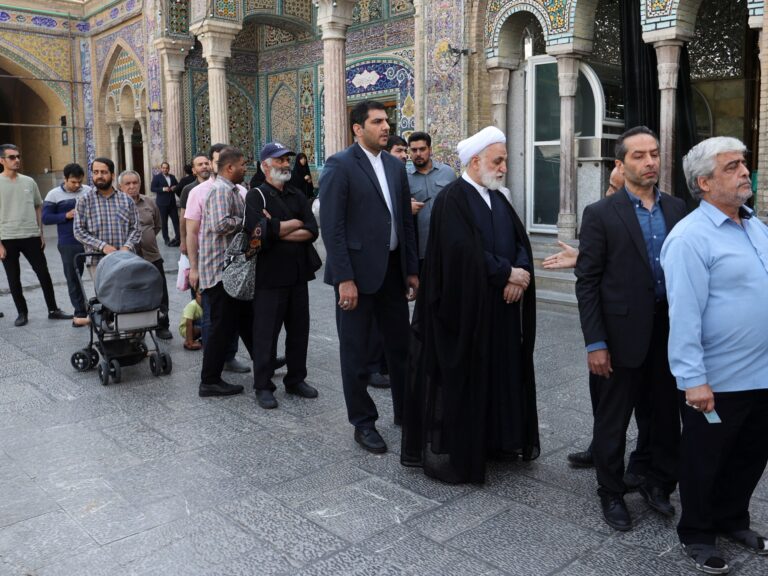Iranians are voting to choose a new president from among four candidates loyal to the tightly controlled supreme leader amid growing public discontent following the death of Ebrahim Raisi in a helicopter crash.
Voting opens at 8am (4:30am GMT) on Friday and is due to close at 6pm (6:30pm GMT), but voting hours could be extended until late at night.
The early elections coincide with a period of rising tensions in the region due to Israel’s current war with Iranian allies Hamas in the Gaza Strip and Hezbollah in Lebanon, Iran’s first direct attack on Israel in April, and increasing Western pressure over Iran’s nuclear program.
The election is unlikely to bring about any major changes in Iranian policy, but its outcome could have implications for who will succeed Iran’s Supreme Leader Ayatollah Ali Khamenei, 85, who has been in power since 1989.
A council of six Khamenei-aligned scholars and six legal scholars vetted the candidates. It approved only six of the original 80 candidates, after two others dropped out.
Prominent among the remaining hardliners are Mohammed Bagher Ghalibaf, speaker of parliament and former commander of the Islamic Revolutionary Guard Corps (IRGC) air force, and Saeed Djalili, a former nuclear negotiator who served in Khamenei’s office for four years.
The only relative moderate, Masoud Pezeshkian, remains loyal to Iran’s theocracy but advocates détente with the West, economic reform, social liberalization and political pluralism.

Voter turnout is key
Voter turnout has plummeted over the past four years as young people become frustrated with political and social restrictions.
Al Jazeera’s Zeina Khodr, reporting from Tehran, said voter turnout was key to the outcome because a high voter turnout would give the sole reformist candidate a chance.
“He needs about 55 to 60 percent of the vote,” she said, adding that “the very fact that the vote is split among conservatives means that a second round is a real possibility.”
“Voting turnout is important to the establishment too. The second time I heard from Ali Khamenei he was calling for mass voting,” Khodr said.
“In Iran, the elections are seen as a referendum on the regime, its legitimacy and the general sentiment in the country.”
Khamenei called for high voter turnout to offset a crisis of legitimacy caused by public discontent over economic hardship and restrictions on political and social freedoms.
“The durability, strength, dignity and reputation of the Islamic Republic depends on the existence of its people,” Khamenei told state television after the vote. “A high voter turnout is absolutely essential.”
Interior Minister Ahmad Vahidi said some 60,000 polling stations and 90,000 “polling points” have been set up across the country, including more than 300 polling stations overseas.
The Interior Ministry said Friday that more than 61 million people are eligible to vote both at home and abroad.
complex feeling
A mix of emotions is brewing on the streets of Tehran as the voting progresses.
“Elections can be beneficial for the people, especially those who are looking for support and assurances for the future,” Maria Jaafari told Al Jazeera.
“I don’t have high expectations for this election because the president is not the main decision maker in the government hierarchy here,” said Amir, another voter.
Final results are expected to be released within two days as ballots are counted manually, but initial figures could come sooner.
If no candidate receives at least 50% of the total votes, including blank votes, plus one, a runoff election will be held between the top two candidates on the first Friday after the election results are announced.
Three of the candidates are hardliners and one is a low-profile relative moderate who enjoys the support of reformists who have been largely ignored in Iran in recent years.
With Khamenei retaining sole authority over the country’s highest political affairs, the next president is not expected to make any major policy changes regarding the country’s nuclear program or support for militias across the Middle East.
But the president is in charge of the day-to-day running of the government and can influence the direction of Iran’s foreign and domestic policies.
All four candidates have pledged to revive Iran’s struggling economy, plagued by mismanagement, state corruption and reimposed sanctions since 2018 after the United States abandoned the 2015 Iran nuclear deal with six other world powers.
The hashtag “#ElectionCircus on X” has been widely used in Iran over the past few weeks, with some activists both at home and abroad calling for a boycott of the election, arguing that a high turnout would legitimize the Islamic Republic of Iran.
Follow our election updates here.

